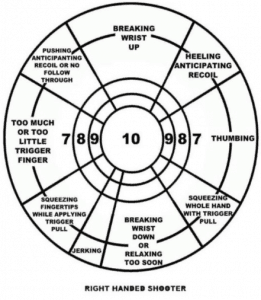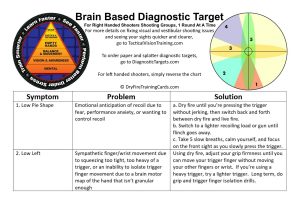
These “old school” diagnostic targets just don’t work for defensive shooters.
For years, I have mocked diagnostic targets. I love the idea behind them, but they’re designed for slow fire, 1 handed, bullseye shooting using light single action triggers. Besides telling you the problem and not the solution, they just don’t work for 2 handed defensive shooting.
To be clear, in my opinion, “defensive shooting” doesn’t equate to sloppy shooting, “combat accurate” shooting, or shooting hand sized groups when there’s no stress, full light, and no movement.
If you’re going to have a gun for defensive use, I think you should be able to drive tacks with it in sterile conditions.
Because if you can drive tacks in sterile conditions, there’s a much better chance you’ll be able to get those “combat accurate” groups you want when you add in movement, chaos, and stress.
So why do instructors around the globe teach classes of students standing flat footed shooting paper on a well lit range that 8” groups are good enough?
There’s a few reasons, but one of the biggest is because instructors are in the horrible position of trying to teach too much stuff in too little time. They typically don’t have time to take shooters off and work with them individually. Even if they do, 8″ groups are normally “good enough” for most tests and quals.
When you’re instructing, you want to see a shooter shoot to see if there’s anything they should change. Normally, you don’t even need to look at the target to know how to help them…you can see it as the shooter is shooting.
But, sometimes, when you’re working with a line of shooters, the bullets have already flown by the time you get to a shooter, and all you have left is a pattern of holes on a target and a few seconds to give them feedback before you move to the next shooter.
Over time, many instructors develop a mental checklist that they go down when they see certain group patterns.
It could be low, low left, to the left, to the right, stringing up and down, horizontal stringing, high & left, etc.
The biggest problem with old-school diagnostic targets is that not all problems are a result of your technique.
Patterns show up on targets for several reasons besides technique.
They could be mechanical due to the trigger being too heavy, too long, or sights being loose.
They could be due to hypoxia (as I found out once when I had pneumonia, O2 levels in the 80s, and consistently shot high), holding your breath, or hyperventilating.
They could be due to the size of your hand, injuries, or strength of your finger.
More importantly, as I have gone deep into my study of performance neurology, I’ve seen that there are neurological issues in the brain that can show up on the target.
Brain based issues are awesome, because a lot of times, we can make a quick brain based change and get immediate results…even when shooting at full speed. With technique changes, it can take several hundred reps over a few weeks for changes to stick.
There are group patterns that show up on targets as a result of hand pain from arthritis, fear of recoil and performance anxiety, or even a bad “map” of the hand in the brain.
And there are group patterns that show up as a result of visual issues like being cross eye dominant or when your visual cortex combines the images that both of your eyes are receiving incorrectly (which is incredibly common.)
So, I took the mental checklist that I use with shooters that includes all of these factors and made a brain based diagnostic pistol splatter target & chart that will actually work for shooters when they’re shooting on their own.
Start by eliminating as many variables as possible by standing 6-10 feet away from the target and slow-fire shooting 5-8 shots at the center of the target with the goal of driving every single round through the same hole. Since most pistols come with a 25 yard factory zero, you may hit a little low when you’re shooting this close. That’s fine…keep aiming for the center of the target and don’t adjust your aim.
Even if you’re a point/target focus/threat focus/instinctive shooter, start by eliminating variables and using your sights.
The targets have high-contrast orange horizontal and vertical lines so that you can focus on your front sight and still make horizontal and vertical adjustments with your peripheral vision…without taking your focus off of the front sight.
One note…it’s important when using splatter targets to keep your focus on the front sight and assess your hits with your peripheral vision. Don’t let the target suck your focus downrange between shots. This will create a vertical stringing pattern on your target and is a training scar you want to avoid.
At that distance, you can’t really blame the accuracy of the gun, ammo, or wind if you miss. The sights might be off or loose, but odds are, it’s something you’re doing and that you can fix.
If you drill all of the rounds through 1 hole, keep adding distance until you get a 4-6” group. The splatter target will make it easy to see where you’re hitting as you extend the distance.
If you don’t drill all of the rounds through 1 hole, then see which numbered pattern your group looks like? Are all of the shots low? That would be a type 1 group. Are your shots stringing left and right? That would be a type 3 group.
Next, look at the diagnostic chart and see what the most common causes of that group pattern are.
Most of these will be things that you have seen, heard, or read before. That’s ok. You see, the problem for most shooters isn’t a lack of knowledge about shooting. It’s trying to remember all of the details after the bullets start flying.
The diagnostic chart is coated to resist damage from water, oil, blood, and the crushed dreams of your enemies (Thanks, Alex) and is designed as a cheat sheet to remind you of things that an instructor would tell you if he was with you on the range.
Some patterns, like a horizontal stringing group, could have several potential causes…some of them are visual suppression issues, loose sights, too tight of a shooting hand grip, too heavy/long of a trigger for your finger, or a gun that’s too big/small for your hand/grip, and more.
Start working through the quick fixes and you’ll be back on target in no time.
This will save you time and money, make range time more fun, and it’ll keep you from hardwiring bad technique into your brain.
Once you’ve got your baseline accuracy dialed in, then start adding in speed, stress, movement, decision making, and other factors to make your training more realistic, but any time you start missing, get back to the basics, eliminate variables and get yourself recalibrated with the brain based diagnostic targets & chart.
I feel like I have to make a point of saying that these targets don’t replace instruction from a qualified instructor. They don’t cover all patterns and it’s impossible to solve all problems and keep compact. They’re designed to remind you of lessons that you’ve learned in the past but are likely to forget on the range.
The idea is the same as medics and nurses carrying laminated drug interaction cards and why my EMT med kit has flip chart / pocket reference to remind me of things I know, but can’t always remember exactly when I need the information.
What’s the best part about the targets & chart?
Unlike the old school diagnostic targets, these actually work for defensive shooters. They’ll save you time, money, and help you avoid locking in bad habits.
You can get 20 of the brain based diagnostic splatter targets for the price of 10, 2 of the coated diagnostic charts, and free shipping >HERE< Because we have to print several thousand of the splatter targets at a time, they’re only available in the right handed version for now, but if you’re a lefty you can simply flip the charts in your head or you can get a left-handed print-at-home version >HERE<
You can also get the splatter targets & chart as part of a DVD training package >HERE<
Questions? Comments? Fire away by asking below.



1 Comment
Dick M.
January 6, 2018Very interesting article, depending on the firearm i am using i found that some preform better as a left handed weapon. (Accuracy). This has been with both long guns and hand guns.
Oh, i am left handed, right eye dominate. I would like to hear your thoughts on this, as well as why i find some weapons are more suited for me as left handed.
Thank you for ur time,
Dick M.
Leave A Response To Dick M. Cancel reply